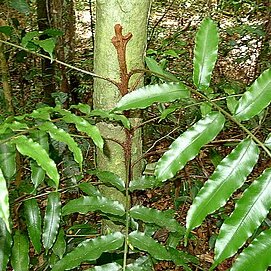Terrestrial lithophytic or epiphytic ferns. Rhizome short-to long-creeping or climbing, bearing roots only on the ventral surface, scaly at the tips. Scales lanceolate and peltately attached or cordate and attached at the sinus. Fronds dorsal on the rhizome, simple and entire or 1-pinnate (rarely 2-pinnate in non-Australian genera); fertile fronds usually smaller or with narrower pinnae than sterile fronds. Stipe articulated or decurrent on the rhizome. Pinnae articulated or decurrent on the rachis; veins free or anastomosing, with or without free included veinlets. Sporangia borne over most of the ventral surface; indusia absent. Spores with a convoluted wing-like perispore or sometimes spiny.
Epiphytic or terrestrial; rhizome wide (rarely short) creeping or climbing, dorsiventral in structure with roots arising from the ventral surface; leaf–bases more or less decurrent as ridges on the upper surface of the rhizome; apex of rhizome covered with scales which may be cordate but not peltate; stipes jointed near the base in Elaphoglossum, with several vascular strands arranged in a U
Terrestrial, lithophytic, epiphytic or hemi-epiphytic ferns. Rhizomes short-to long-creeping or climbing, clothed with scales

